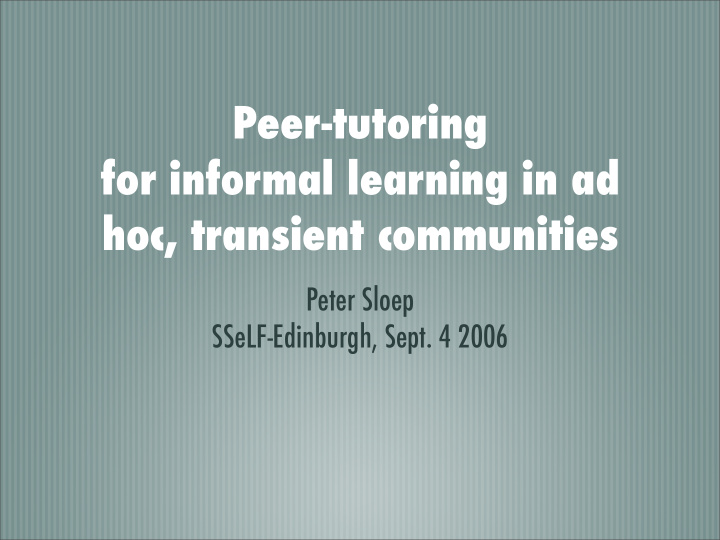



Peer-tutoring for informal learning in ad hoc, transient communities Peter Sloep SSeLF-Edinburgh, Sept. 4 2006
Programme Set the stage with respect to today’s theme - 10 min Social software for informal learning - 20 min Discussion in Groups, Conclusions - 30 min Break - 15 min Social Software for Peer Tutoring - 15 min Plenary Discussion - 15 min
SSeLF’s key words for today
E-learning definition: ‘web-technology enhanced learning’ technology is no mere instrument, neutral with respect to its context of use technology cannot be used or ignored at will technology influences context of use, the user’s views, the problem space technology becomes a cultural force itself
Informal Learning Formal learning by accredited institution, often curriculum and cohort based Non-formal learning not by accredited institution Informal learning no curriculum, no cohorts, individual education shopper
Social Learning Computer Supported Collaborative Learning is excluded relative small groups, subgroups of cohort, assembled by teacher, required to complete assignment set by teacher My setting is a ‘Learning Network’ relatively large group of informal learners, varying interaction intensities over time and group space, formation of ad hoc, transient communities
Social software: definitions,examples,principles
Definitions
Definitions (history) Social software is (Tom Coates, plasticbag.org, May 8th, 2003) a tool for augmenting human social and collaborative abilities a medium for facilitating social connection and information interchange an ecology for enabling a system of people, practices, values, and technologies in a particular local environment
My working definition (educational) social software is all software that facilitates the development and maintenance of social structures in online (learning) communities
Examples instant messaging (ICQ, AIM, MSN, Skype) forums blogs (podcasts, vlogs) wikis, collaborative editing social bookmarking (del.icio.us, furl) virtual werelds
IM: iChat
Skype
The temperature is a measure for the average kinetic energy of molecules. Energy is needed to increase their speed and hence the temperature. How much energy is needed per degree depends on the molecular mass (their number) and their kind (metal need little, water needs a lot).
Recommender systems Amazon, iTunes, Navigation service in learning environment No social software human to data communication versus human to human communication
General principles
Technological (Web 2.0) September 2005, Tim O’Reilly described the seven principles that underpin Web 2.0 [Google: Tim O’Reilly, what is web 2.0?] They may be considered design principles of social software
Distributedness The web as platform: the more the merrier (Reed’s law: number of groups increases with 2 to the power of the number of users) Utilises collective intelligence: wikipedia, blogging It’s about data: Amazon’s recommendation system, G-mail
Programming No more software releases: Google Lightweight programming models: webservices (best example: RSS) or XML over http Software for the network, not just for a single device: iTunes works on PCs and iPods Rich user experience: active content via Java etc. (best example: Google maps)
Cultural Our read-and-listen cultural has all but ceased to exist. We live in: a multimedia environment, dominated by images in which computers are online 24/7, ready to assist us We are different than children below 25 Marc Prensky’s digital immigrants and digital natives!
Educational social software emphasises communication - the read and write web - while thus far the web was about information - the read web social software seams to be the instrument of choice to support a social-constructivist pedagogy
Discussion
Because of social software, for the first time in history e-learning is able to offer an adequate learning experience. Without social software, informal learning is doomed to fail. Through social software, you do not acquire deep knowledge or genuine friends. Social software is a communication technology, not a learning technology. The use of social software has serious dangers (intellectual property rights, privacy).
Coffee Break
Peer-tutoring in ad hoc transient communities
Problem Teacher bandwidth problem: teachers and tutors are involved in one-to-one interactions with students rather than one-to-many Students easily become isoloated (‘lone learner’)
Solution use peers as tutors to answer non-trivial questions develop software that makes this feasible, without human intervention ASA = Agent-led Support Activities (under construction!)
Moodle LSA module Tutor locator
ask question
ask question Ask your question What is the difference between heat and temperature? If it gets warmer, the temperature gets higher too! But apparently the same amount of heat can lead to different temperature increases. How come? Cancel Submit
compute similarity
documents 1 2 3 j m ape 5 11 0 left 1 2 33 the 110 156 144 kind 25 19 0 terms i fr(ij) n f(mn)
set up discussion
The temperature is a measure for the average kinetic energy of molecules. Energy is needed to increase their speed and hence the temperature. How much energy is needed per degree depends on the molecular mass (their number) and their kind (metal need little, water needs a lot). set up discussion
In summary ASA is a piece of social software it creates ad hoc, transient communities it is designed to work in informal learning contexts (learning networks) it should help solve the teacher bandwidth problem and the lone learner problem
Overall conclusions
Overall conclusions Educational social software fits the rapidly changing culture of our youths fits modern pedagogical views such as sociaal-constructivism requires much R&D if it is to be used effectively and above all in a pedagogically sound way
Thank you for your attention! Peter B. Sloep Fontys Hogescholen Open Universiteit Nederland mail: p.sloep@fontys.nl peter.sloep@ou.nl web: http://www.ou.nl/open/psl
Recommend
More recommend